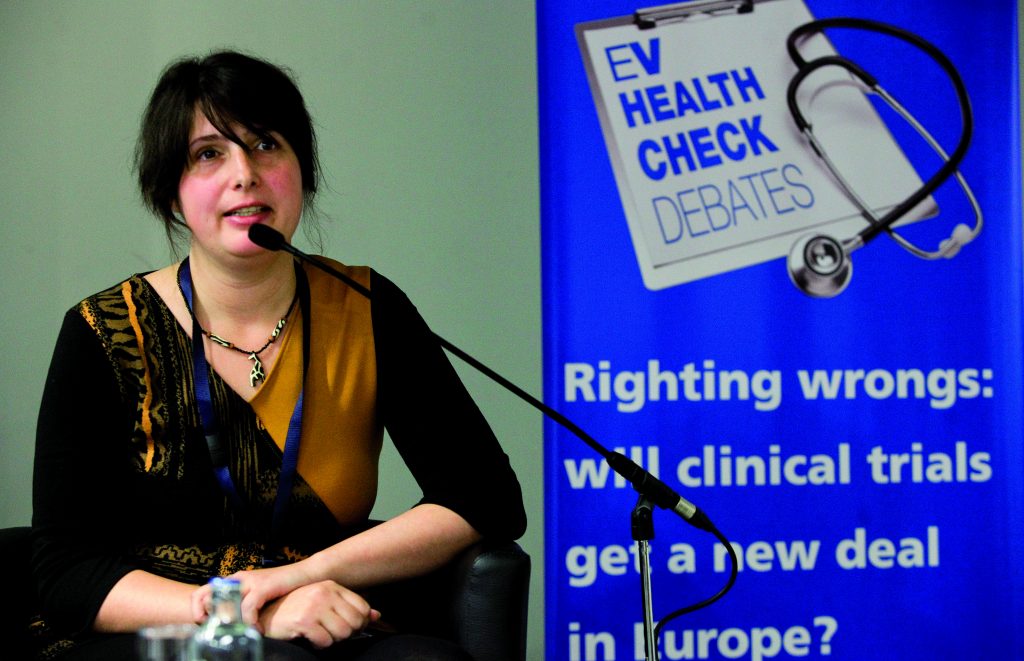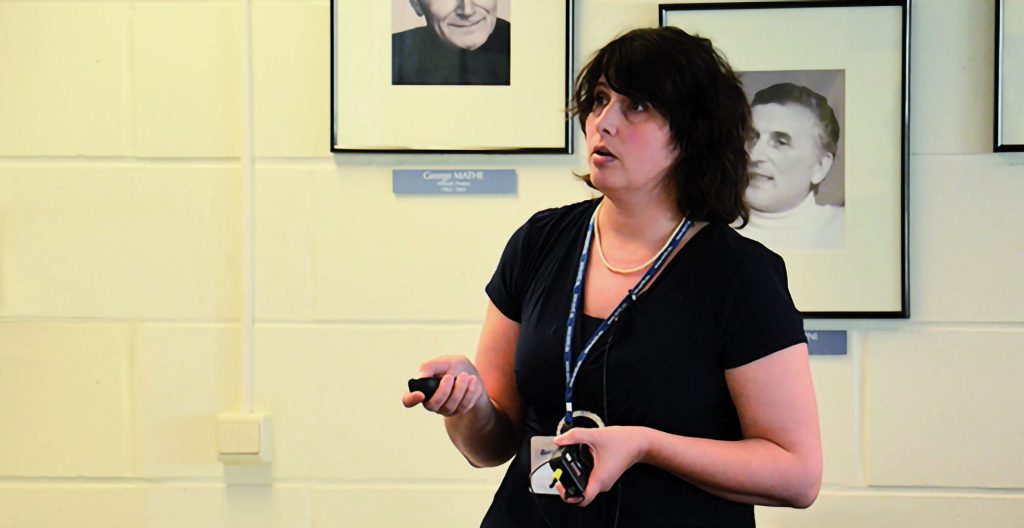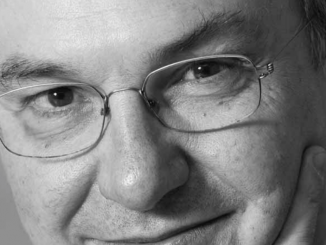Legislators and policy makers could do a lot more to promote cancer research if they understood that improving treatment strategies is not all about new drugs, and that patients and health budgets pay a high price for failures to coordinate across Europe. Anastassia Negrouk tells Sophie Fessl about her efforts to get those messages across.
“When you look at society and see something is wrong, you can either just complain about it, or you can get involved and fix it,” says Anastassia Negrouk, Head of the International Policy Office at EORTC. Her decision was to get involved and try to fix it.
EORTC, the European Organisation for Research and Treatment of Cancer, is Europe’s largest non-commercial sponsor of academic clinical trials. The job of Anastassia Negrouk and her team is to analyse how regulations affect patients, and how they affect Europe as a clinical trials location. “A number of regulations are relevant to our activities in clinical cancer research, from clinical trials regulation to data protection. I follow up on these key dossiers, to see they are drafted and implemented in the right way.”
A major point on Negrouk’s agenda was and still is the EU Clinical Trials Regulation. This regulation will replace the controversial 2001 Clinical Trials Directive, which, for all its good intentions, is widely believed to have paved the way for a drop of up to 25% in the rate of new trials being registered.
Negrouk was part of the attempt to turn this around: “When the new Clinical Trials Regulation was in development, I wrote articles to welcome the rethink and drafted position papers. Now, I’m involved in its implementation as part of the multi-stakeholder group at EMA [the European regulatory agency].”
The original Clinical Trials Directive turned clinical trials in Europe into a nightmare of red tape, requiring trials sponsors to negotiate separate procedures often with multiple bodies in each country where patients would be enrolled. But Negrouk is happy with the new legislation: “The Clinical Trials Regulation is a very good example of what Europe can do when things are worked out in a transparent and cooperative way,” she says. “Most added value is given by the coordinated assessment of trials, and the single submission portal for clinical trial applications and authorisations. The transparency that this portal will ensure is key to public trust.”
From lab to legislation

It was personal experience that first led Negrouk to train as a biologist – and then later led her to swap the laboratory bench for a job in cancer policy. “My grandfather, who I loved dearly, passed away from cancer when I was three years old. I was then always interested in cancer, and studied biology at University of Louvain in Belgium. For my end-of-studies work, I investigated the toxicities of cancer drugs on cells in vitro. I continued working in the lab for a few more years, developing a new anti-cancer drug derived from doxorubicin, aimed at reducing toxicities.
During these years, Negrouk gained an insight into the research process – the logistics of the job and the battle for funding – that was to prove invaluable in informing her later policy work. But she soon realised that life at the lab bench was not for her, and started looking for other ways to help the research effort.
Working for a pharmaceutical company did not appeal. “I was not sure about working for industry, as I’m very ‘not-for-profit’ in my ways. By chance, I met a doctor whose wife worked at EORTC, and he told me about the organisation. When my contract at the lab ended, I saw a position as data manager at EORTC, applied and was accepted.”
From there, Negrouk “slipped” into working on regulations: “I started working on intergroup cooperation, in which I set up the cooperation between different cancer research organisations. Part of this work is looking at regulations, which of course differ between countries and continents. And when you learn about regulations, you become somehow frustrated. When I become frustrated, I want to fix it. This is how I came into working on policy.”
With a staff of three, the EORTC Office of International Policy is quite small. But this gave Negrouk a unique vantage point. “I look at all the different regulations at the same time, and can see when regulations are not consistent, or even contradict each other. These divergencies do not help patients, they just make research more expensive without any added value. A major plea of EORTC is to have more harmonised and consistent regulations at the European level.”
These divergencies may directly affect Europe’s competitivity in clinical trials, explains Negrouk, who cites as an example the way transparency obligations are applied to novel diagnostics. “In the Clinical Trials Regulation, transparency is very important. Information entered in the clinical trial portal is public, unless you have commercially confidential information, in which case the publication may be postponed. But this [let-out clause] applies only to information related to the drug itself,” she says. In the Regulation on in vitro diagnostic medical devices, by contrast, the demands for transparency are less stringent, she says. “I wonder – what will be the result if a company has very confidential information on in vitro diagnostics, in the scope of a phase III clinical trial?… Without putting in question the general need for transparency, if companies have doubts about their obligations regarding what they consider confidential information, they may well decide not to come here.”
From Negrouk’s work as EORTC’s data protection officer, she also sees potentially negative impacts on research of the Data Protection Regulation (DPR), which will be implemented from May 2018 onwards: “The amount of paperwork needed to comply with the DPR is overwhelming. I am not sure that it provides any additional favours for patients, or just adds costs. I’m much more aware about privacy scandals around primary healthcare institutions, such as medical files that are released in a non-appropriate scope. But I do not recall any scandals about a misuse of research data. Also, while the healthcare area is one of the biggest targets of hacking, the research area is not. There is no information about the risks associated with the sort of pseudo-anonymous data we hold. It is questionable if all of this is proportionate to the risks – I think the DPR is overshooting.”
The reason for this cautious approach, Negrouk suggests, may be a disconnect between regulators and health research: “Regulators may not always be knowledgeable of the realities in the field. The regulation is very general, speaking about scientific research, which is much larger than health research, and overall does not operate in the strict legal environment that we in health research do. As there was no quick consensus, a lot was delegated to the member states, which almost completely annihilated any interest to have a regulation. Harmonisation in data protection is worse than before the DPR.”
Not just another bureaucrat
Negrouk has now worked at EORTC for 17 years, and sees the risk of becoming a pen-pusher. “When you work on your computer all the time, the notion of patients can become a bit theoretical. You risk becoming just one more bureaucrat.” But in 2011, EORTC decided to involve the patient community in its activities in a structured way – a responsibility that Negrouk’s unit took on. “Working with patients and patient organisations, I discovered a whole different world – and it is a part of my work that I really love,” Negrouk enthuses. “When confronted with the patient community, you recall why you are doing your work, why it is important. I find it extremely inspiring that the patient community – whether patients themselves, advocates, or family members – have the strength to overcome difficult situations and use their anger at dysfunctions in the system in a very constructive way.”
EORTC’s activities involving patients range widely. “Every two years, we organise a patient advocacy course, which I chair. We also have patient representatives on our panel on the protection of research subjects. We exchange opinions and work on position papers on policy with patient organisations.” EORTC also involves patient advocates in reviewing their clinical trial concepts. “They give us input on whether the trial design would be acceptable to patients. It is better to involve patients from the start, because from one type of disease to another, and from one treatment consequence to another, a trial may be more or less acceptable.”
But some difficulties persist: “It is challenging, as we work in an extremely regulated environment. We are creating the interface between a caring patient community who have a lot at stake, and the clinical research community, where timelines are important, and where they have a very structured and somewhat distant style of communication and working.”
And as input from patient advocates is sought from increasing numbers of organisations, there is a growing problem with finding patients with the necessary expertise and the time to spare. “Those who are willing to contribute are overbooked. If the community wishes to continue with patient engagement, patient advocacy groups will need more people to be involved and more structural support to enable this.”
Clinical research ≠ drug development
EORTC’s mission is to improve standards of cancer treatment for patients. Yet a review of therapies approved for solid tumours between 2002 and 2014 showed that the median gains in progression-free and overall survival have been 2.5 and 2.1 months, respectively (JAMA Otolaryngol Head Neck Surg 2014, 140:1225–36). Does Negrouk believe this is OK?
“We should not say ‘we don’t accept these little advances,’ we should demand that these little advances are built upon”
“What are two additional months of life worth? If we discuss this on the level of society, it is a very dangerous debate. I personally don’t believe that society can decide this, as opposed to individuals,” argues Negrouk. “The real debate is slightly different. We should not say ‘we don’t accept these little advances,’ we should demand that these little advances are built upon. We should not forget that childhood leukaemia is pretty much treatable now because little advances were steadily built upon.”
But Negrouk doesn’t rush to blame the system: “With maintenance treatments, which we now see more frequently, we have a clear conflict of interest from the perspective of industry. This is not attributing blame, it’s just a fact, and we need to have a counterbalance in society. This could be a role played by academic institutions. Once the drugs are on the market, they could look at the exact treatment length. Does it really have to be forever? It would be in the interest of healthcare systems to support such academic work, as it would save them a lot of money.”
Denis Lacombe, Director General of EORTC, recently wrote a piece titled, “Let’s be honest – our research centres on drugs not patients” (Cancer World Winter 2017/18). Negrouk agrees that he has a point. “We need to get away from the idea that it will be a new drug that saves the patient. In cancer, this is so not true. It is the combination of treatment strategies that saves lives. We need to create a system that is complementary, with industry discovering new molecules and making drugs available to patients and the academic community, and on the other hand an academic community that fine-tunes how to optimally use those molecules.”
Fixing the problem of drug-centred research will not be easy, as the problem is essentially political, argues Negrouk: “The system is drug-centred because the pharma industry is there to develop new molecules and will always think in relation to their molecule portfolio. If we want society to think from the patient angle, we need to start from the patient.”
What this means in practice, she argues, is to start by finding the exact nature of the patient’s disease, and then go on to see what the available optimal treatment is. “But this is not easy – doctors do not necessarily have a full picture of all emerging treatment opportunities,” says Negrouk.
Clinical trials registries, such the EU’s EudraCT or clinicaltrials.gov, run by the US National Institutes of Health, are of course a step forward in helping doctors and patients access information about potentially relevant trials, she says, but the problem is that these only concern drugs.
“You might like to have a full picture of what is available to your patient, also including interventional trials with or without drugs, such as surgery, radiotherapy, or a combination.” This has so far proved impossible, says Negrouk. “EORTC tried to put in place a register for all clinical research carried out, not just clinical trials. But when we speak to EU parliamentarians, they say, ‘We have just put this in place – it’s the drug trial registry.’ They still do not realise that clinical research is not just a means to develop a new drug.”
Fixing the system
 Don’t just complain, fix it, is Negrouk’s motto. One way to fix the system, she suggests, would be to set up clinical trial infrastructures that can address most of the common regulatory problems in one go: “Such infrastructure helps us carry out projects more efficiently, and is the basis for EORTC’s partnership with other scientific and leading organisations in conducting complex international research projects.”
Don’t just complain, fix it, is Negrouk’s motto. One way to fix the system, she suggests, would be to set up clinical trial infrastructures that can address most of the common regulatory problems in one go: “Such infrastructure helps us carry out projects more efficiently, and is the basis for EORTC’s partnership with other scientific and leading organisations in conducting complex international research projects.”
She is a strong supporter of two of the new, more holistic, data collection infrastructures launched in recent years by EORTC. SPECTA is an integrated and shared European platform that collects biological material and correlates relevant clinical data to learn more about how cancer develops, but also to see which treatment protocols may be proposed. YOU, Your Outcome Update, is a platform for long-term follow-up, beyond the usual five-years disease-free survival looked at by most companies (see also ‘Gathering long-term data on what happens next’).
“With YOU, we have the opportunity to go back to patients who participated in the original trial, and ask whether they would contribute to discovering something, for example, about late toxicities. In collaboration with registries, we can build a comparison between how cancer patients do in clinical trials compared to in real-life treatment, and develop new methodologies.”
Battling red tape on a daily basis would frustrate most people. But not Negrouk: “I have a very analytical mind, and do not find legislation frustrating. What I do find frustrating are all the little differences between member states, which complicate organising pan-European research a lot. These are usually just cultural or historical preferences. Europe must recognise that they need to unite if they want to offer their citizens the prospect of high-quality and affordable healthcare, underpinned by high-quality pan-European research.”





